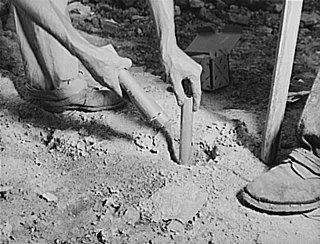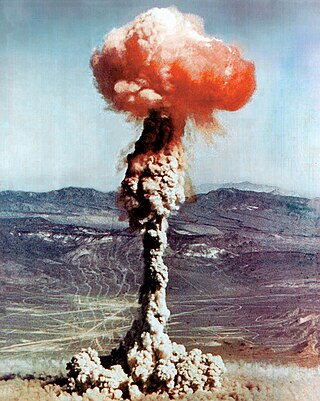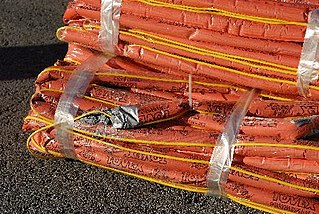
RDX (abbreviation of "Research Department eXplosive" or Royal Demolition eXplosive) or hexogen, among other names, is an organic compound with the formula (CH2N2O2)3. It is white, odorless, and tasteless, widely used as an explosive. Chemically, it is classified as a nitroamine alongside HMX, which is a more energetic explosive than TNT. It was used widely in World War II and remains common in military applications.

Dynamite is an explosive made of nitroglycerin, sorbents, and stabilizers. It was invented by the Swedish chemist and engineer Alfred Nobel in Geesthacht, Northern Germany, and was patented in 1867. It rapidly gained wide-scale use as a more robust alternative to the traditional black powder explosives. It allows the use of nitroglycerine's favorable explosive properties while greatly reducing its risk of accidental detonation.

An explosive is a reactive substance that contains a great amount of potential energy that can produce an explosion if released suddenly, usually accompanied by the production of light, heat, sound, and pressure. An explosive charge is a measured quantity of explosive material, which may either be composed solely of one ingredient or be a mixture containing at least two substances.

Nitroglycerin (NG), also known as trinitroglycerol (TNG), nitro, glyceryl trinitrate (GTN), or 1,2,3-trinitroxypropane, is a dense, colorless or pale yellow, oily, explosive liquid most commonly produced by nitrating glycerol with white fuming nitric acid under conditions appropriate to the formation of the nitric acid ester. Chemically, the substance is a nitrate ester rather than a nitro compound, but the traditional name is retained. Discovered in 1846 by Ascanio Sobrero, nitroglycerin has been used as an active ingredient in the manufacture of explosives, namely dynamite, and as such it is employed in the construction, demolition, and mining industries. It is combined with nitrocellulose to form double-based smokeless powder, used as a propellant in artillery and firearms since the 1880s.

Trinitrotoluene, more commonly known as TNT (and more specifically 2,4,6-trinitrotoluene, and by its preferred IUPAC name 2-methyl-1,3,5-trinitrobenzene), is a chemical compound with the formula C6H2(NO2)3CH3. TNT is occasionally used as a reagent in chemical synthesis, but it is best known as an explosive material with convenient handling properties. The explosive yield of TNT is considered to be the standard comparative convention of bombs and asteroid impacts. In chemistry, TNT is used to generate charge transfer salts.

C-4 or Composition C-4 is a common variety of the plastic explosive family known as Composition C, which uses RDX as its explosive agent. C-4 is composed of explosives, plastic binder, plasticizer to make it malleable, and usually a marker or odorizing taggant chemical. C-4 has a texture similar to modelling clay and can be molded into any desired shape. C-4 is relatively insensitive and can be detonated only by the shock wave from a detonator or blasting cap.
Nitromethane, sometimes shortened to simply "nitro", is an organic compound with the chemical formula CH
3NO
2. It is the simplest organic nitro compound. It is a polar liquid commonly used as a solvent in a variety of industrial applications such as in extractions, as a reaction medium, and as a cleaning solvent. As an intermediate in organic synthesis, it is used widely in the manufacture of pesticides, explosives, fibers, and coatings. Nitromethane is used as a fuel additive in various motorsports and hobbies, e.g. Top Fuel drag racing and miniature internal combustion engines in radio control, control line and free flight model aircraft.
Polymer-bonded explosives, also called PBX or plastic-bonded explosives, are explosive materials in which explosive powder is bound together in a matrix using small quantities of a synthetic polymer. PBXs are normally used for explosive materials that are not easily melted into a casting, or are otherwise difficult to form.

Amatol is a highly explosive material made from a mixture of TNT and ammonium nitrate. The British name originates from the words ammonium and toluene. Similar mixtures were known as Schneiderite in France. Amatol was used extensively during World War I and World War II, typically as an explosive in military weapons such as aircraft bombs, shells, depth charges, and naval mines. It was eventually replaced with alternative explosives such as Composition B, Torpex, and Tritonal.
Insensitive munitions are munitions that are designed to withstand stimuli representative of severe but credible accidents. The current range of stimuli are shock, heat and adjacent detonating munitions. A munition can have its vulnerability reduced by a number of means used on their own or in combination such as a reduced vulnerability energetic material, design features, additions or changes to packaging etc. The munition must still retain its terminal effect and performance within acceptable parameters.

Composition B, also known as Hexotol and Hexolite, is a high explosive consisting of castable mixtures of RDX and TNT. It is used as the main explosive filling in artillery projectiles, rockets, land mines, hand grenades, and various other munitions. It was also used for the explosive lenses in the first implosion-type nuclear weapons developed by the United States.

TNT equivalent is a convention for expressing energy, typically used to describe the energy released in an explosion. The ton of TNT is a unit of energy defined by convention to be 4.184 gigajoules, which is the approximate energy released in the detonation of a metric tonne of TNT. In other words, for each gram of TNT exploded, 4.184 kilojoules of energy are released.
Nitramex and Nitramon Explosives are compositions of various chemical compounds. They are explosives based on ammonium nitrate, with other ingredients such as paraffin wax, aluminum and dinitrotoluene. The inclusion of these additional ingredients creates a more stable explosive. Nitramex and Nitramon have in modern times been replaced by more advanced high explosives based on ammonium nitrate, such as ANFO.
In explosive materials, strength is the parameter determining the ability of the explosive to move the surrounding material. It is related to the total gas yield of the reaction, and the amount of heat produced. Cf. brisance.

A seismic source is a device that generates controlled seismic energy used to perform both reflection and refraction seismic surveys. A seismic source can be simple, such as dynamite, or it can use more sophisticated technology, such as a specialized air gun. Seismic sources can provide single pulses or continuous sweeps of energy, generating seismic waves, which travel through a medium such as water or layers of rocks. Some of the waves then reflect and refract and are recorded by receivers, such as geophones or hydrophones.

Tovex is a water-gel explosive composed of ammonium nitrate and methylammonium nitrate that has several advantages over traditional dynamite, including lower toxicity and safer manufacture, transport, and storage. It has thus almost entirely replaced dynamite. There are numerous versions ranging from shearing charges to aluminized common blasting agents. Tovex is used by 80% of international oil companies for seismic exploration.
IMX-101 is a high-performance insensitive high explosive composite mixture developed by BAE Systems and the United States Army to replace TNT in artillery shells. IMX stands for "Insensitive Munitions eXplosives", which refers to the purpose of IMX-101: to provide explosive force equivalent to TNT without its sensitivity to shocks such as gunfire, explosions from improvised explosive devices, fire, and shrapnel. For example, it is believed that a training incident in Nevada which killed seven Marines would not have occurred with the new explosive. On March 23, 2013, the United States Army ordered $780 million worth of the explosive, with a production of millions of pounds annually, to be produced by BAE at Holston Army Ammunition Plant in Tennessee. The new explosive will cost $8 per pound, compared to $6 per pound for TNT. As of 2023, IMX-101 filled shells are being used in the 2022 Russian invasion of Ukraine.

Nitrotriazolone (NTO) is a heterocyclic semicarbazide-derived high explosive first identified in 1905, but research into its explosive properties was not conducted until the 1980s. NTO is currently being used by the US Army in munitions, specifically Insensitive munitions replacing those made with legacy explosives.

Kathryn Grove Shipp was an American organic chemist, a specialist in explosives, affiliated with the Naval Ordnance Laboratory from 1957 to 1970. In 1967, she was one of the six recipients of the Federal Woman's Award.

Active Seismic Experiment (ASE) was carried on Apollo 14 and Apollo 16 as part of the Apollo Lunar Surface Experiments Package (ALSEP). ASE used a thumper device and a mortar with explosive charges to explore subsurface lunar structure and elastic properties. The experiment's principal investigator was Robert Kovach of Stanford University. The experiment was succeeded on Apollo 17 by the Lunar Seismic Profiling experiment.














